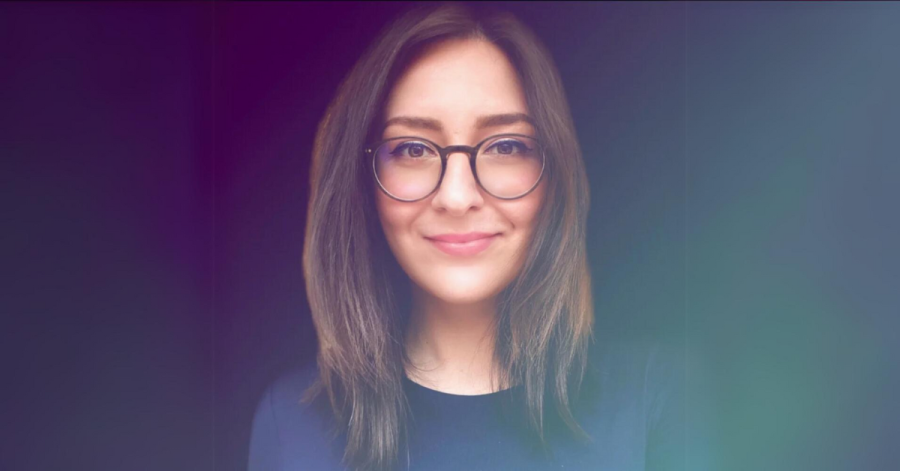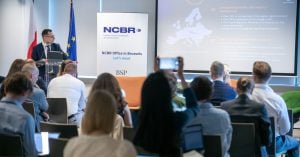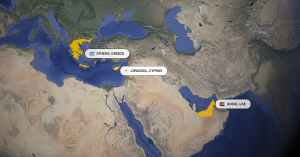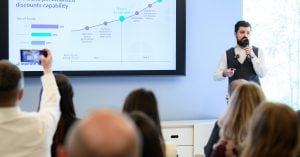Only have 1 minute? Here are 3 key takeaways:
- From Romania to Amsterdam to London, Georgia Diaconescu has gained extensive experience in product marketing and value proposition.
- She is the marketing lead at Flourish by Canva, a data visualization platform that enables organizations to create engaging, easy to publish visualizations.
- Her collaboration with Griffin Robotics, a US-based VC that invests in Seed and Series A startups targeting large consumer markets, keeps her close to the startup ecosystem in CEE.
Embarking on a remarkable professional journey that spans countries and industries, Georgia Diaconescu is a seasoned marketing professional and product marketing expert with a diverse background in technology and innovation. Hailing from Romania, Georgia’s passion for connecting with diverse cultures led her to pursue her studies in Amsterdam and eventually settle in the bustling tech hub of London.
After taking on different roles in augmented reality startups to bigger teams like Meta and Canva, Georgia is now leading the marketing team at Flourish, a data visualization platform acquired by Canva in 2022.
Besides her main job, Georgia is an active woman in tech, contributing to the tech community, mentoring in different incubators and accelerators. She is also collaborating with a Silicon Valley-based VC firm, Grishin Robotics, scouting for innovative ideas in Central and Eastern Europe.
The Recursive interviewed Georgia on product marketing, the importance of a clear value proposition and why startups from CEE will be the next hit.
The Recursive: Georgia, your professional journey is quite impressive, starting from Romania, studying in Amsterdam, and now in London. Can you share more about your experiences and career path?
Georgia Diaconescu: I’ll start by saying that I left Romania because I always knew that I wanted to live abroad, I wanted to go and meet different people and cultures; not because something was fundamentally wrong with staying.
I completed my Bachelor’s at a private school in Romania, where I had the opportunity to have as professors experienced senior executives and market-embedded individuals, who also possessed the right theoretical background. Many were marketplace experts, balancing teaching with their practical work. This diverse faculty offered real-life stories and insights on various aspects, including pitching, interviewing, and more. It provided a comprehensive 360-degree perspective.
Later, I pursued my Master’s in Marketing in Amsterdam, inspired by an ad portraying a creative team ideating, with a bunch of ideas flying in the air. It sounds silly, I know. But it deeply resonated with something I had on my heart, which was to work with interesting technologies and products, and be part of an environment that’s creative and challenging. While studying abroad, I found my first full-time job at an augmented reality startup through a post on Twitter. This experience provided me with the opportunity to work with big brands and senior stakeholders, allowing me to see the hidden stories behind their requirements, and how their businesses work.
I then transitioned from account management to business development, and I moved to London after a British company acquired our startup. Despite the initial plan of staying for a year or so, I’ve been in London for seven years. Leaving Amsterdam was tough, but it was a strategic move for career development.
I landed in product marketing after being approached for a role related to what I was already doing in my business development role —crafting value propositions and tailoring messages for different audiences. So I started working in an innovation hub within a larger FMCG corporation where I learned a lot about product management and product marketing. Later, I worked in FinTech, concentrating on credit products, which provided me with a fresh and informative perspective on how consumers perceive added value when it comes to managing their finances.
And then I joined-what3words, a location technology company. I was the only product marketing manager in a fantastic marketing team that ran – very much like an in-house agency. The role involved a lot of App Store optimization and bridging the gap between product and marketing teams.
At Meta, I worked on internal business products, delving into the intricacies of client operations and performance analysis.
And then Canva came up. I always kept an eye out for Canva because I’ve been a power user for a long time. And then when I spotted this role for Flourish, I was like: “This is it!”. I’ve been working with data products or products that visualize a lot of data for other people. I know a lot of the pain points, at least from a business perspective, working with business analysts and product managers.
On this journey, I met so many phenomenal people, from managers to colleagues. They are just so smart and I’ve learned so much from them. Also, the Canva team’s culture is absolutely amazing. I met the founders back in May and they are the most generous, kind, and down-to-earth people.
Yet, one of the most formative experiences I’d say was one that I had in Amsterdam, leading a local chapter for women’s network, which was called Levo League. That was really formative because I realized that everyone who was at my stage of the career or even just maybe a bit further ahead was in search of mentorship, support, and understanding how to negotiate, how to talk with your stakeholders on all these different things. It made me very aware of the fact that I’m the CEO of my own career. So then, if I am the CEO of my own career, then I need to take action and I can’t just sit here and wait for things to be given. I have to create opportunities for myself as much as I can (always with a caveat of making sure I can honor these opportunities and don’t burnout).
We know a lot about Canva and how it changed our lives. But tell us a bit more about Flourish – what it does, who it addresses, and more.
Flourish is a data visualization platform that has been created by two fantastic founders. And I’m not exaggerating when I say that. Co-founded by Duncan Clark and Robin Houston and was launched in 2018. Both of them used to work for The Guardian, – incredibly accomplished professionals. A dynamic duo that have the perfect combination of analytical and creative. Duncan was previously a data journalist, publisher and author, while Robin is a mathematician and developer. They both started working on custom visualizations as a side project in 2012. Eventually, they set up an award-winning data visualization studio. At the core of it, they noticed how time consuming it was to create data visualizations that are beautiful, informative and really interactive. was working with data visualization as a journalist. And so, he was looking for a way to create data visualizations that are informative and they’re really interactive. So that when people read an article they actually get to the gist of things rather than just very static information. It was quite a hassle to do without having to code it. And so they dreamed Flourish into a real product – a tool to allow non-coders to create high-end visualizations and stories without the cost and delays of commissioning bespoke projects.
As a data visualization platform, it enables anyone from journalists to teams of knowledge workers, part of – businesses like management consulting, agencies, content creators, education providers, and students to create engaging, easy to publish visualizations. You can see why it’s so aligned with Canva’s mission of empowering the world to design. We’re here to help everyone communicate with data.-. You have a rich library of templates, you pop your data in there, you customize the visualization, and then it’s all ready to publish. You can add it to your Canva presentation or embed it on your website. You’ve probably already spotted Flourish visualizations in BBC or Financial Times articles, along with many other brands. There are quite a few companies who use it, including BBC and the Financial Times.
You’ve worked a lot with crafting the value proposition for different products. Thinking about the startup ecosystem more broadly, what advice would you give to founders, especially regarding the early stages of developing a product and its value proposition?
That’s one of the first things that we talk a lot about with the startup incubators. If you just define what a value proposition is, it is understanding how you add value to your customers. So you start with who you are adding value to. And I think that everything will start from the customer profile. Largely speaking, founders and early startups will have noticed the problem in the market that they want to create a solution for. And that’s great. But there are so many different ways to solve the same problem. And there are so many different, adjacent problems that you could be solving with the same thing as well.
So how do you figure that out? And which one to focus on? I’m a big fan of the jobs-to-be-done methodology as well. I think that’s a really helpful way to look at things. What jobs are you helping the customer get done? Starting with the customer profile and understanding who they are, what are their jobs to be done, what are they aiming to do, and how they are comparable to all the other customer profiles that maybe you have in mind when you’re building that solution.
The bottom line here is you shouldn’t address all the problems because if you’re trying to address all of them, you’re probably not going to do great. Focusing on the ones that are both the most underserved and the most important. The delta between how bad it hurts me as a customer that this problem isn’t solved and how important it is, that part is the opportunity score essentially. Where you have the highest opportunity score and you think your skills and your team are able to deliver on that, I think that can be a great starting point. Look at your customer profile, your value map, what you’re building, and the value exchange that happens between the two. Based on that, you get to figure out if you can assign a value to each of those exchanges.
It could be making things simpler, and more efficient, it could be control, you give people full control, or you give customizability. And then based on that, it’s a lot easier to start formulating messaging and looking at your positioning map. I highly recommend the Strategyzer framework here.
Your best scenario is to develop a few MVP versions of the value proposition as a startup and go interview potential customers, asking them about their experience, how they feel about the solution, and what makes sense to them. And you nurture that group of customers to be part of your customer advocacy group along the way.
What tools would you recommend them to use in the process so they can do the mockups, capture the answers, and collaborate with the team in creating the value proposition?
I would highly recommend Canva whiteboards. There are a lot of really helpful templates- for capturing feedback, but also adding rich media and additional context. Usertesting.com is also a fantastic option. But for mocking up or ideating things, we did all our value proposition work in Canva whiteboards. The best thing about it is that you can create it as a standalone whiteboard, but you can also add it to a deck, so it’s easy to keep everything in the proper context.
We talked about the positive side of things, but tell me about the failures too. What’s been some hard tasks you worked on in product marketing, some weird projects maybe, or challenges, and how did you come out of those situations?
One that comes to mind speaking of the value proposition was early on when I first started to use frameworks. There were many situations when I just applied them like bandaid on a wound, so to speak. And I think I was at that stage in my career where I thought a framework was the answer. I’ll just plaster it there instead of thinking of it as a tool and just taking a moment to look at the problem in front of me and analyze what in my toolkit could I use.
It was a product that was very heavy, like a B2B product, almost a B2B2B product, kind of assessing the return on investment on Amazon and stuff like that. I distinctly remember a situation where that didn’t work and the product owner called it out. It was a little bit jarring, but I was like, you know, I think I see where you’re coming from. I think we probably need to look at a different way to approach this. And we ended up using a very old-school value chain analysis tool that’s like from the 80s, Michael Porter style. And it worked. I mean, it helped complement what I needed to do. The biggest learning from that was not applying frameworks blindly over everything that kind of looks like the same challenge.
Considering that startups have limited resources, what should they work on first, product development or product marketing?
The truth is, without adoption, a product will simply fade out of existence. It’s a shift in mindset, as developing a product isn’t a matter of creating it and passing it off to marketing. Instead, it’s crucial to focus on its uptake.
Get a thinking partner for yourself as a founder or product manager, someone who I personally think should be one of the first hires. A well-rounded product marketer product marketing, or someone with a growth background, to act as a thinking partner to you to tell you what’s happening in the competitive space, how much people are charging somewhere else, how are people thinking about this problem, what is major opportunity space (important, but unsatisfied needs). And then, as you’re doing that discovery process and the building of the product, they can also do some of that validation of the messaging in the meantime. If founders think of marketing as a moment in time when they’re ready to go to market, it’s already too late, most likely.
Besides being a product marketing expert, you also collaborate with a VC firm from the US. What is their interest in CEE and who are they looking to invest in?
Yes, it’s Grishin Robotics based in Silicon Valley and with an outpost in London. They have a nice startup portfolio, including Ring, a manufacturer of home security and smart home devices, acquired by Amazon and some other great companies. We are a team of scouts who look for different ideas and try to spot those matching with the VC’s investment thesis.
The GRx team invests in Seed and Series A startups targeting large consumer markets such as online entertainment, gaming, food, education, team productivity and collaboration.
I have a strong feeling that there are many value-adding businesses and intellectual property emerging from Central and Eastern Europe. A lot of really good concepts are being developed here that actually address the markets that they would be interested in. I hope that VC funds continue to increase their focus on this region. Companies here in CEE can truly surprise with their problem-solving abilities and competitiveness with Western markets, so to speak.
Excited to see what the future holds for this region!








